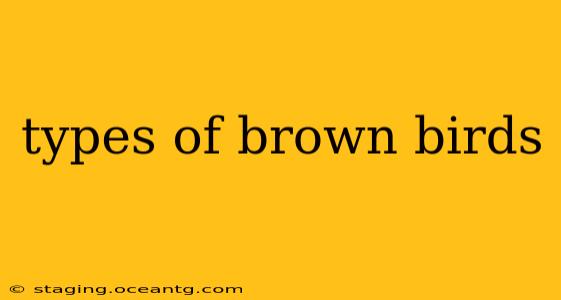The world of birds is incredibly diverse, and brown birds, in particular, represent a significant portion of this variety. Their plumage, often providing excellent camouflage, makes them masters of disguise, but that doesn't mean they're all the same. This guide dives deep into the fascinating world of brown birds, exploring different species, their habitats, and key characteristics to help you identify them.
Identifying Brown Birds: Beyond the Basic Brown
Before we delve into specific species, it's important to remember that "brown" is a broad term. The shades of brown can vary dramatically – from light tan to dark chocolate – and often include hints of other colors like reddish-brown, grayish-brown, or even olive-brown. Furthermore, the markings, size, and behavior of the bird are crucial for accurate identification. Look closely at:
- Shades of Brown: Is it a warm, reddish-brown, a cool grayish-brown, or something else entirely?
- Markings: Does it have streaks, spots, bars, or other patterns?
- Size and Shape: How big is the bird? What's the shape of its beak and tail?
- Habitat: Where did you see the bird? Different species favor different environments.
- Behavior: What was the bird doing? Was it hopping on the ground, perched in a tree, or flying?
What are Some Common Types of Brown Birds?
This question often tops the list for bird enthusiasts. The answer, unfortunately, isn't a simple one, as countless species feature brown plumage. However, we can highlight some of the more frequently encountered brown birds across various regions:
North American Brown Birds:
- Northern Cardinal (Male): While the female is a more muted brown, the male's vibrant red is a striking exception. Their crest and distinctive song are key identifiers.
- American Robin: While often depicted as red-breasted, their backs are a rich brown, and they are easily recognized by their size, behavior, and distinctive song.
- House Sparrow: A common, adaptable bird found in urban and suburban areas, they're generally brown with streaks and a short, stubby beak.
- Brown Thrasher: Known for their long tails and striking reddish-brown coloration, they inhabit woodland areas.
- Mourning Dove: A slender bird with a long tail and a soft cooing song, they are frequently spotted in open areas and gardens.
European Brown Birds:
- Common Sparrow: Similar in appearance to the House Sparrow, but with slight variations in markings.
- Robin (Erithacus rubecula): While known for its red breast, the back is predominantly brown. The size and behavior are helpful in distinguishing it from other brown birds.
- Wood Pigeon: Larger than many other brown birds, easily identified by its size and cooing sound.
- Tawny Owl: Nocturnal bird with brown plumage providing excellent camouflage.
Other Regions:
Many brown bird species are found throughout the world. Researching birds native to your specific region is key to accurate identification. Remember to use field guides specific to your location for the most effective results.
How Do I Identify Brown Birds More Easily?
Accurate identification takes practice and patience. Here are some tips to help you:
- Use a Field Guide: Invest in a quality field guide specific to your region.
- Pay Attention to Detail: Note the shades of brown, markings, size, shape, habitat, and behavior.
- Take Photos: Photos can be incredibly helpful in later identification.
- Use Bird Identification Apps: Many apps utilize image recognition to assist in identification.
- Join a Birding Group: Connect with experienced birders for guidance and support.
What are Some of the Smallest Brown Birds?
Many small brown birds exist, making precise identification challenging. Size estimations can be subjective, but some species known for their smaller size often exhibit brown plumage. Always consult regional field guides for accurate size comparisons and identification.
What is the Biggest Brown Bird?
The "biggest" brown bird depends on the region and specific definition of "brown." In many areas, larger birds of prey, such as some species of eagles or hawks, might have significant brown coloration in their plumage, though often with other colors present as well.
Are All Brown Birds the Same?
Absolutely not! While many birds share a brown plumage, the subtle differences in shading, markings, size, behavior, and habitat are critical for accurate species identification. The diversity within the "brown bird" category is vast and fascinating.
This comprehensive guide provides a starting point in your journey to identify the many fascinating species of brown birds around the globe. Remember that continued observation, utilizing resources, and engaging with the birding community are key to expanding your knowledge and appreciation of these often overlooked feathered friends.
